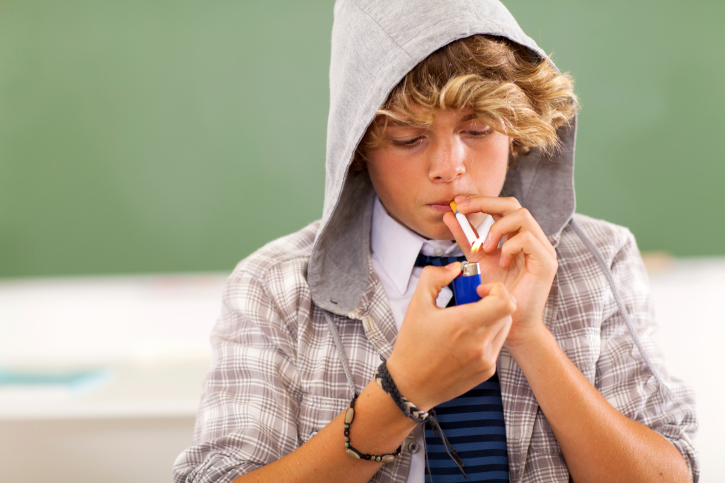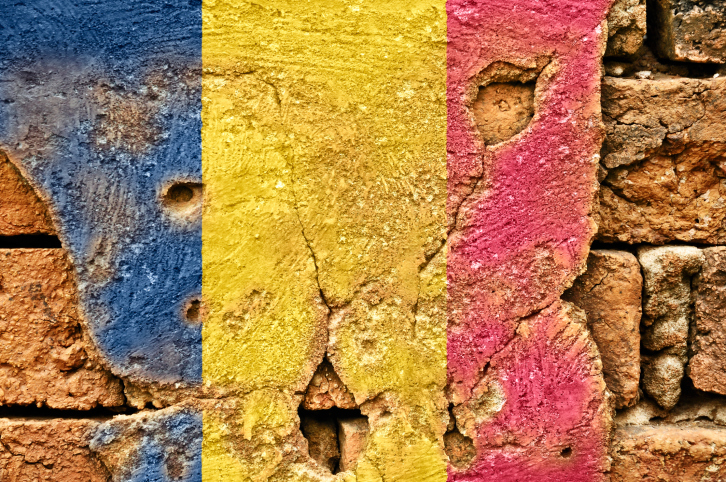(单词翻译:单击)
Brazil takes pride in its five World Cup trophies, while Denmark relishes the title of "World's Happiest Country." But not all records are positive. Here are 10 you really wouldn't want your country to hold.
巴西因其获五届世界杯奖杯闻名于世,而丹麦因"世界最幸福的国家"而被人称颂。但并不是所有的纪录都是好的。你肯定不愿意让自己的国家赢得以下10种世界冠军。
10.Austria--Most Smokers
10.奥地利--吸烟率最高

As most people know by this point, smoking is essentially an expensive cancer lottery. But apparently Austria didn't get the memo, since it holds the record for the highest proportion of smokers—around 36.3 percent of the population. With over a third of Austrians regularly lighting up, the wealthy European nation can claim the highest smoking rate in the world. An estimated 60 percent of the 20–50 age group—some 2.5 million people—admitted to smoking regularly or semi-regularly in 2010. And things don't seem to be improving much—41 percent of the 15–20 age group are also regular smokers, while a further 8 percent admitted to sneaking the occasional cigarette.
很多人都知道这样一点,吸烟是导致癌症的根本因素。但是奥地利民众显然不理会这种说法,这个国家保持着最多吸烟者的记录--大约占人口总数的36.3%。有超过三分之一的奥地利人吸烟,因此这个富裕的欧洲国家可以被称为世界上吸烟率最高的国家。据估计,2010年有约60%的20岁至50岁民众--大概250万人--承认经常吸烟或偶尔吸烟。这种情况似乎并没有多大改善--41%的15岁至20岁年龄组的人也是经常吸烟者,另外还有8%的人承认偷偷吸烟。
The country's nicotine fixation has created friction with its neighbors. In 2009, Austria belatedly enforced an EU anti-smoking directive requiring large restaurants and bars to set aside at least 50 percent of their seating area for non-smokers. The move caused widespread outrage, with many business owners saying they would openly flout the law for fear of losing their customers. In 2010, only 19 percent of Austrians said they would support a full ban on smoking in restaurants and other enclosed spaces, leaving the country's 3.5 million smokers free to continue their habit for the foreseeable future.
奥地利因吸烟问题与邻国发生了点小摩擦。到2009年,奥地利才执行欧盟的禁烟法令,要求大型餐馆和酒吧至少留出50%的非吸烟者座位区。此举引发众怒,许多企业主公然藐视该法律,因为他们害怕失去顾客。2010年,只有19%的奥地利人称他们支持在餐馆和其他封闭空间禁烟,剩下的350万吸烟民众将继续他们的吸烟习惯。
9.Belarus--Heaviest Drinkers
9.白俄罗斯--最严重酗酒

Alcoholism is heartbreaking on an individual level, but things can get even worse when a whole country seems to have a drinking problem. According to the World Health Organization (WHO), the average Belarusian consumes 17.5 liters (3.9 gal) of pure alcohol every year, almost three times the global average of 6.2 liters (1.4 gal). If that doesn't sound bad enough, the average Belarusian male consumes 27.5 liters (6 gal) per year. Of the country's total alcohol consumption, spirits accounted for 46.6 percent, while beer and wine made up a further 22.5 percent. A disturbingly high 30.9 percent of alcohol consumed was simply listed as "other"—probably referring to the discount fruit wines and homemade vodka beloved by the nation's 170,000 recorded alcoholics.
在个人层面上,酗酒是令人心碎的,但当全国都有酗酒问题时,事情就变得更糟糕了。世界卫生组织(WHO)公布,白俄罗斯人平均每年消耗纯酒精17.5升(3.9加仑),近乎全球平均消耗6.2升(1.4加仑)酒精的三倍。如果这听起来还不算糟糕,白俄罗斯男性平均每年都要消耗27.5升(6加仑)纯酒精。在该国的酒精消耗总量中,烈酒占46.6%,而啤酒和葡萄酒占22.5%。而另外高达30.9%的酒精消耗量属于其他酒类--也许是水果酒和自制的伏特加,这由该国的170000名酗酒者保持着纪录。
Belarus's government has disputed the WHO report, claiming that the actual figures are much lower. But the government itself came in for criticism when it emerged that the lower average they provided included young children and newborn infants, who tend not to be heavy drinkers. Thankfully, the government has instituted a strong anti-alcohol program, including heavy fines for drunk driving and a ban on homemade fruit wines. There are even plans to raise the drinking age from 18 to 21. Drink prices have also risen considerably, with the cost of vodka doubling over the last few years. However, liquor seems to be ingrained in the culture of Eastern Europe—according to the WHO report, the top five alcohol-consuming nations all hail from the region.
白俄罗斯政府质疑WHO的报告,声称真实数据低的多。当白俄罗斯政府提供包括根本不会喝酒的小孩和婴儿的数据被暴露后,遭到了人们的批评。值得庆幸的是,政府已经制订了一个强有力的反酗酒法律,包括对酒后驾车的高额罚款和禁止自制水果酒。甚至还有计划将饮酒年龄从18岁提高到21岁。酒类价格也大幅上涨,在过去几年里,伏特加的成本翻倍。然而,酒似乎在东欧文化里根深蒂固--根据世界卫生组织报告显示,世界前五名饮酒国家都来自该地区。
8.South Korea--Most Cosmetic Surgery
8.韩国--最流行整容

In a world where looks are seemingly everything, it's not surprising that some people feel enormous pressure to conform to society's standard of beauty—even if that means undergoing expensive, painful, and potentially dangerous surgery. Things are particularly bad in South Korea, where plastic surgery is practically an everyday occurrence. An estimated one out of every five South Korean women has had some cosmetic work, four times higher than the rate among American women. The country's plastic surgeons have developed an international reputation—around 7.5 million people have traveled to Seoul to have work done, including many members of the Korean diaspora.
在这个世界上,容貌似乎就是一切(看脸的世界)。所以毫不奇怪,有些人在为符合社会审美的巨大压力下,接受昂贵的,痛苦的并且有潜在风险的整容手术。在韩国整容尤其泛滥,整形手术几乎每天都会发生。据估计,每五个韩国女性中就有一个就受过整形手术,高出美国女性四倍。韩国的整形手术已经享誉世界--大约750万人去首尔接受整形手术,包括许多韩国侨民。
Why does South Korea have such an obsession with surgery? No one really knows, although anecdotal evidence suggests that Korean women feel heavily judged on their looks. Popular surgeries include procedures to enlarge eyes and reshape noses and jaws. As one plastic surgery patient told ABC News: "I think everyone is trying to delete this Koreanness. In Korea, you go down the streets, you see this girl. And you walk down the street, and you see that girl again. It actually is a different person."
为什么韩国如此痴迷整形手术?尽管有证据显示韩国女性对自己的容貌非常苛刻,但没有人真正清楚。最受欢迎的手术有放大眼睛,重塑鼻子和下巴。一个整形手术病人告诉美国广播公司:"我想每个人都想删掉这个韩国标签。在韩国,你会在街上看见这个女孩,沿着街走,又再次看见这个女孩。事实上,这是两个不同的人。"
7.Honduras--Highest Deforestation Rate
7.洪都拉斯--最高森林砍伐率

Deforestation is a global problem, but some countries have it worse than others—and Honduras just might have it worst of all. According to the Global Forest Resources Assessment Report, the Central American country lost the fourth highest percentage of its forests between 1995 and 2005, behind the Comoros, Burundi, and Togo. However, the total forest cleared in Honduras dwarfed the losses in the other three—despite its relatively small size, Honduras was actually in the top 20 countries for total forest lost. When the two measures are taken into account, it seems like Honduras might well have the worst deforestation problem in the world.
森林砍伐是一个全球性问题,但有些国家更为严重--洪都拉斯就是森林砍伐最严重的国家。根据全球森林资源评估报告显示,这个中美洲国家在1995年和2005年间丢失的森林比例中排名第四,在科摩罗,布隆迪和多哥之后。然而,洪都拉斯的森林砍伐总量相较于其他三国,相形见绌--尽管国土面积较小,实际上,洪都拉斯的森林砍伐名列前20国中。考虑到这两个因素,洪都拉斯似乎就是世界上森林砍伐问题最严重的国家了。
An estimated 70 percent of the Honduran population lives in severe poverty, and firewood is often their only source of cooking fuel. Local coffee farmers don't always realize the effects of runoffs from chemicals used in the pulping process. There are more surprising reasons as well—an increase in drug smuggling through the country has seen deforestation rates skyrocket. Clearing forests for agriculture provides an easy way for traffickers to launder their profits, and they usually have the muscle to ignore conservation groups and muscle indigenous groups off their land. Thanks to the "narco-effect," large-scale deforestation quadrupled in Honduras between 2007 and 2011.
据估计70%的洪都拉斯人生活极其贫困,而柴火往往是他们做饭的唯一燃料。当地的咖啡农并没意识到从制浆过程中使用化学物质的影响。还有更让人惊异的原因--毒品走私的增加加剧了森林砍伐。砍伐森林而转耕农业为走私者提供了洗黑钱的简便渠道,并且他们通常有能力忽视环保组织和驱赶本土民众离开他们的土地。由于"毒品效应",洪都拉斯的大规模森林砍伐率在2007年和2011年间翻了两番。
6.Chad--Lowest Life Expectancy
6.乍得--最低平均寿命

With a life expectancy of only 49 years, Chad is officially the worst country to be born in. Malnutrition is the largest factor in the country's shockingly short average lifespan—as a desert nation, Chad is extremely susceptible to drought and other natural disasters. To make matters worse, the recent conflict in neighboring Sudan has created a devastating refugee crisis, with thousands streaming across the border in search of safety. Chad has also suffered from decades of civil war and a brutal conflict with the Libyan regime of Muammar Gadhafi.
平均寿命只有49岁的乍得,被公认为寿命最短的国家。乍得作为一个沙漠国家,营养不良是导致平均寿命非常短的最大因素。乍得极其容易受到干旱和其他自然灾害。更糟糕的是,最近的邻国苏丹冲突造成相当严重的难民危机,数千民众为寻求安全而越境。乍得还遭受了数十年与卡扎菲政权的内战和残酷冲突。
As if that wasn't bad enough, Chad is in the middle of an HIV/AIDS epidemic. An estimated 3.4 percent of the adult population are living with the disease and over 120,000 children have lost their parents because of it. Water is an increasingly rare commodity—only around 4 percent of the rural population have a safe source of clean drinking water, leading to regular outbreaks of diarrhea, cholera, and typhoid fever. In a country where there is only one doctor for every 38,000 people, these diseases are heartrendingly deadly.
如果说这还不够糟糕,乍得还盛行艾滋病。据估计3.4%的成年人都患有艾滋病,并且超过120000小孩因为艾滋病失去父母。日常用水也变得越来越困难--大约只有4%农村人口有安全干净的饮水来源。饮用脏水导致他们经常腹泻、霍乱和伤寒。这个国家,每38000人中只有一个医生看病,而这些疾病都是致命的。
翻译:夏久梅 来源:前十网


